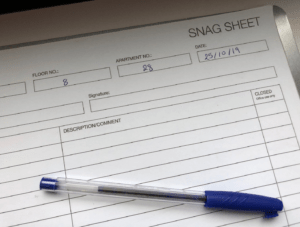
Snagging Inspections: Pro vs. DIY for New Home Quality
Protecting Your Investment – The Importance of a Snagging Inspection Buying a newly built home is an exciting milestone, but it’s crucial to ensure your investment is sound. Snagging inspections
Latest News

In recent years, new build homes have surged in popularity across the UK. The government’s commitment to addressing housing shortages has led to the construction of thousands of new properties nationwide. These homes are particularly appealing to buyers due to their modern designs, energy efficiency, and the fact that they often come with fewer immediate maintenance needs compared to older homes. Additionally, new builds are often available in desirable locations with convenient access to amenities and transportation links.
However, despite their advantages, purchasing a newly built home can come with its own set of challenges. One of the most critical aspects for buyers is understanding their rights and protections when investing in these properties. Being well-informed about your legal protections and the warranties available can help ensure a smooth buying process and provide peace of mind. It can also empower you to address any issues that may arise after moving into your new home.
When buying a newly built home in the UK, several legal protections are in place to safeguard your interests. These protections are designed to ensure that the property you purchase meets specific standards and that any issues that arise are appropriately addressed.
One of the most well-known protections for newly built home buyers is the NHBC (National House Building Council) warranty. This warranty is designed to cover various aspects of the new build process, providing buyers with significant peace of mind.
By understanding these legal protections and the specifics of the NHBC warranty, new-build home buyers can feel more secure in their purchase, knowing they have recourse if things go wrong.
A snagging list is a crucial tool for newly built home buyers. It is essentially a checklist of defects or unfinished work that needs to be addressed by the builder. Compiling a thorough snagging list ensures that any issues are identified and rectified before you fully settle into your new home.
Definition: A snagging list is a document that details minor defects and unfinished work in a newly built property. It covers a wide range of issues, from cosmetic blemishes to functional faults.
Importance: Creating a snagging list helps ensure that your new home meets the expected standards of quality and finish. It also provides a formal record of any issues that need to be addressed by the builder, facilitating smoother communication and resolution.
While newly built homes offer many advantages, they can also present various defects that need addressing. Some of the most common issues include:
Ensuring that any defects are promptly and effectively addressed is essential for maintaining the quality and safety of your newly built home.
Steps to Take if Defects are Found:
Timing is critical when it comes to conducting a snagging inspection. The optimal times to carry out an inspection are:
Hiring a professional snagging inspector can be highly beneficial, particularly if you lack experience in identifying construction defects.
Benefits of Professional Inspections:
Cost Implications: The cost of hiring a professional snagging inspector varies depending on the size and location of the property, but it typically ranges from £300 to £600. While this is an additional expense, it can save you money in the long run by ensuring all defects are promptly addressed.
If you prefer to conduct the snagging inspection yourself, here are some practical tips:
When defects are found in your newly built home, it’s crucial to report them promptly and effectively to the developer. Here are some steps to ensure your concerns are addressed:
Understanding the resolution process is vital to ensure that your concerns are addressed efficiently.
In some cases, issues may persist despite your efforts to resolve them with the developer. Here’s what to do:
The UK government offers various schemes and incentives to support newly built home buyers:
If you encounter unresolved issues with your newly built home, you may be entitled to compensation. Here’s a step-by-step guide to making a claim:
In summary, buying a newly built home can offer many benefits, but it’s essential to be aware of your rights and protections. By understanding legal protections, warranties, and the snagging process, you can ensure a smooth and successful home purchase.
Taking proactive steps, such as conducting thorough inspections and effectively reporting defects, will help safeguard your investment. Additionally, knowing how to deal with developers and seek compensation for unresolved issues can provide peace of mind.
Buying a new home is an exciting milestone, but it’s crucial to ensure your new property meets the highest standards of quality and safety. At Home Snagging UK, we specialise in identifying and addressing defects in newly built homes, providing you with peace of mind and protecting your investment.
Why Choose Home Snagging UK?
Contact Us Today
Don’t leave the quality of your newly built home to chance. Schedule a professional snagging inspection with Home Snagging UK and ensure your home is built to perfection.
Visit our website for more information and to book your inspection today!

Protecting Your Investment – The Importance of a Snagging Inspection Buying a newly built home is an exciting milestone, but it’s crucial to ensure your investment is sound. Snagging inspections

The Critical Role of Snagging Key Takeaways: Understand what a snagging list is and why it’s crucial for new homeowners. Learn how to identify both major and minor issues within

The Rise of Digital Platforms Welcome to the evolving world of construction snagging, a pivotal phase in the construction industry where the identification and rectification of small issues or ‘snags’

Ensuring Home Expectations Welcome to Home Snagging UK, where we understand that moving into a new build property is an exciting journey filled with anticipation. However, amidst the excitement, it’s

Essential Role of Snagging Lists In the realm of construction and home inspections, snagging lists play a crucial role in ensuring that new builds meet the highest quality and safety

Why You Need a Snagging Company When investing in a new home, ensuring that your property is free from defects is paramount. A snagging company specialises in inspecting new homes
Barnsley
Beverley
Birmingham
Chester
Chesterfield
Coventry
Derby
Dewsbury
Doncaster
Grantham
Grimsby
Huddersfield
Hull
Huntingdon
Leeds
Leicester
Lincoln
Manchester
Mansfield
Newcastle
Nottingham
Peterborough
Rotherham
Scunthorpe
Sheffield
Shrewsbury
Stoke
Telford
Wakefield
Warwick
Wolverhampton
Worksop
York
We’re home snagging specialists with over 20 years of experience snagging new build homes. We identify construction defects, big or small, that your developer may have missed. We are fully qualified surveyors who work with our customers to make sure they get the perfect home.
© Home Snagging UK 2025
Website Maintained By Be My Social